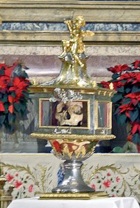


An entry in the Roman Martyrology under 19th January reads:
-
“At Spoleto, in the days of the emperor Antoninus, the passion of St Pontian, martyr, who was barbarously scourged for Christ by the command of the judge Fabian, and then compelled to walk barefoot on burning coals. As he was uninjured by the fire, he was put on the rack, was torn with iron hooks, and then thrown into a dungeon, where he was comforted by the visit of an angel. He was afterwards exposed to the lions, had melted lead poured over him and finally died by the sword”.
St Pontian first appears under 19th January in the Martyrology of Adon (858).
A copy of the legend of St Pontian (BHL 6891b) is preserved under 14th January in the Leggandari del Duomo.
According to the legend (BHL 6891), St Pontian was martyred at Spoleto in the reign of the Emperor Antoninus Pius (138-61) and was buried outside Spoleto, "in loco qui appellatur Lucianus" This is almost certainly the hill that is now called Colle Ciciano, the site of the present church of San Ponziano.
A legend relating to SS Carpophorus and Abundius (who were martyred in 303 AD) says that a pious matron called Sincleta buried their companions "in cimiterio Pontiani, non longe ab urbe Spoletana". This indicates that a cemetery had been established near the grave of St Pontian at least by ca. 850 (when the legend of SS Carpophorus and Abundius was probably written). Three early sarcophagi that were found in this cemetery are now in the crypt of San Ponziano.
The relics of St Pontian were probably preserved in an oratory in the cemetery.
Cult of St Pontian
In 966 Bishop Balderik (who was in Italy for the coronation of Otto II, the young son of Otto I, as co-emperor) took most of the relics to the cathedral of St Martin, which he had built in Utrecht. (The translation is recorded as BHL 6892). As a result, St Pontian is also venerated in Utrecht.
The earliest reliable evidence of the cult of St Pontian in Spoleto dates to the 11th century, when the present church of San Ponziano was built (or rebuilt). His feast day was included in all of the surviving city statutes, the earliest of which dates to 1296.
The cult of St Pontian was revived in 1703, when he was credited with having saved the city from the earthquake that devastated much of the surrounding area. Bishop Pietro Gaddi prayed before what was believed to be the cranium of St Pontian in the crypt of San Ponziano, and the rebuilt chapel in Palazzo Comunale was dedicated to him in 1711.

In 1805, Pope Pius VII formally reconfirmed the authenticity of the sacra testa, which was enclosed in a new silver reliquary at that time. It is still displayed in the Duomo for a week in January each year and then taken back in procession to San Ponziano.
Return to Saints and Venerated Objects of Spoleto.

